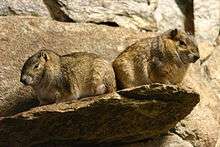Kerodon
| Kerodon Temporal range: Late Pleistocene - Recent | |
|---|---|
 | |
| Rock Cavy (Kerodon rupestris) | |
| Scientific classification | |
| Kingdom: | Animalia |
| Phylum: | Chordata |
| Clade: | Synapsida |
| Class: | Mammalia |
| Order: | Rodentia |
| Family: | Caviidae |
| Subfamily: | Hydrochoerinae |
| Genus: | Kerodon F. Cuvier, 1825 |
| Species | |
The genus Kerodon contains two species of South American rock cavies related to capybaras and guinea pigs.[1] They are found in semi-arid regions of Northeast Brazil known as the Caatinga. This area has a rocky terrain with large granite boulders that contain rifts and hallows where the kerodon primarily lives in.[2]
Characteristics
They are hystricomorph rodents. They are medium-sized with rabbit like bodies, a squirrel face and heavily padded feet. Their nails are blunt on all digits except a small grooming claw on the outermost digit of the foot. Fully grown adult Kerodons weigh around 1000 grams or 31-35 ounces and range in length from 200 to 400 millimeters or 7.5 to 16 inches.[3] They forage for food eating mostly leaves, grass, seeds, and tree bark.[2] Kerdons breed year round usually having 1-3 litters per year and have 1-3 infants per pregnancy. Gestation last around 76 days and the infants are weaned from the mother within 33 days. They reach sexual maturity at 133 days.[4]
Behavior
Like their relatives, the capybaras and the maras, members of the genus Kerodon are highly social.[5] Kerodon, like the capybaras, is polygynous with males forming harems. They are very vocal creatures and make many different whistles, chirps, and squeaks.[3] Males will claim one or several rock piles as their own and will defend their territory. Each male has a few female mates and within each group there is a hierarchy. They are most often active late in the day.[6]
Classification
Traditionally, the genus Kerodon has been considered a member of the subfamily Caviinae along with the guinea pigs and other cavies. Molecular results have consistently suggested Kerodon is most closely related to the capybara, and the two evolved from within the Caviidae.[5] This led Woods and Kilpatrick (2005) to unite the two into the subfamily Hydrochoerinae within the Caviidae. Using a molecular clock approach, Opazo[7] suggested Kerodon diverged from Hydrochoerus (the capybara) in the late Middle Miocene.
Species
- Kerodon acrobata Moojen, Locks & Langguth, 1997 – climbing cavy
- Kerodon rupestris Wied-Neuwied, 1820 – rock cavy
References
- ↑ Woods, C.A.; Kilpatrick, C.W. (2005). "Infraorder Hystricognathi". In Wilson, D.E.; Reeder, D.M. Mammal Species of the World: A Taxonomic and Geographic Reference (3rd ed.). Johns Hopkins University Press. pp. 1538–1600. ISBN 978-0-8018-8221-0. OCLC 62265494.
- 1 2 White, Alex. "Kerodon rupestris". Animal Diversity Web. Retrieved 30 September 2013.
- 1 2 "Rock Cavy". Central Park Zoo. Retrieved 30 September 2013.
- ↑ "Cavies and Maras: Caviidae - Rock Cavy (kerodon Rupestris): Species Accounts". Net Industries. Retrieved 30 September 2013.
- 1 2 Rowe, D. L. and R. L. Honeycutt. 2002. Phylogenetic relationships, ecological correlates, and molecular evolution within the Cavioidea (Mammalia, Rodentia). Molecular Biology and Evolution, 19:263-277.
- ↑ "Cavies and Maras: Caviidae - Rock Cavy (kerodon Rupestris): Species Accounts Read more: Cavies and Maras: Caviidae - Rock Cavy (kerodon Rupestris): Species Accounts". Net Industries. Retrieved 30 September 2013.
- ↑ Opazo, J. C. 2005. A molecular timescale for Caviomorph rodents (Mammalia, Hystricognathi). Molecular Phylogenetics and Evolution, 37:932-937.
Further reading
- Nowak, Ronald M. 1999. Walker's Mammals of the World, 6th edition. Johns Hopkins University Press, 1936 pp. ISBN 0-8018-5789-9